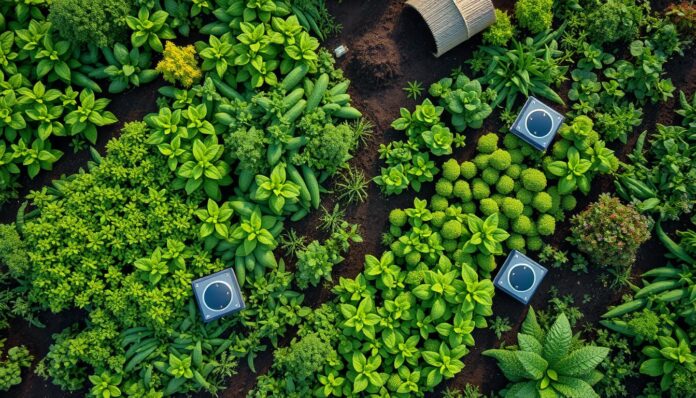Can technology really change sustainable farming from the bottom up? Permaculture sensor networks are changing how farmers see and manage nature. They connect new digital tools with caring for the environment.
Modern permaculture is getting a tech boost. New digital tools help farmers get data fast, use resources better, and make farms stronger.
AI is changing how we manage nature in farms. It uses smart algorithms and computer vision to watch crops and understand the environment. This gives farmers new insights into their farms.
Key Takeaways
- Sensor networks enable precise environmental monitoring
- Digital tools enhance sustainable agricultural practices
- Real-time data collection improves ecosystem management
- AI technologies optimize crop performance and biodiversity
- Permaculture sensor networks represent the future of intelligent farming
Understanding Permaculture and Its Principles
Permaculture is a way to design sustainably, changing how we interact with nature. It started in the 1970s by Bill Mollison and David Holmgren. This approach is different from traditional farming.
Definition of Permaculture
Permaculture is a design system that copies nature’s patterns. It aims to create sustainable and regenerative places. It uses software and apps to improve farming and balance the environment.
Key Principles of Permaculture
- Earth Care: Protecting and regenerating natural ecosystems
- People Care: Supporting human communities and individual well-being
- Fair Share: Redistributing surplus resources and promoting equitable practices
- Observing and interacting with natural systems
- Capturing and storing energy efficiently
Importance of Sustainability
Sustainable farming is key to solving global environmental issues. Farming causes about 25% of greenhouse gas emissions. Permaculture is a way to fight climate change.
“Permaculture is a philosophy of working with, rather than against nature, of protracted and thoughtful observation rather than protracted and thoughtless labor.” – Bill Mollison
| Permaculture Aspect | Environmental Impact |
|---|---|
| Biodiversity | Reduces ecosystem disruption |
| Water Management | Minimizes water resource strain |
| Soil Health | Increases organic matter and fertility |
By using permaculture software and new designs, farmers can make ecosystems that are strong and work well with nature.
Introduction to Sensor Networks
Sensor networks are changing how we collect data and monitor the environment. They are made up of smart devices that work together. This is helping us understand and interact with our surroundings better, like in permaculture and farming.
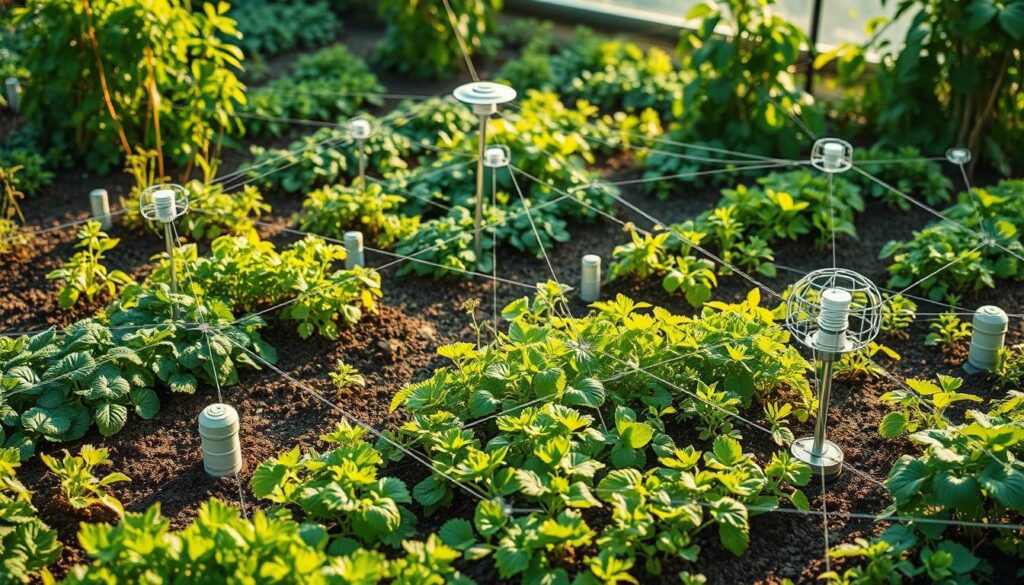
What Are Sensor Networks?
Sensor networks are complex systems of devices that gather and send data about the environment. In permaculture, they help track and analyze important farming data.
- Detect environmental changes in real-time
- Provide comprehensive data streams
- Support advanced decision-making processes
Types of Sensor Networks
There are many types of sensor networks, each for different monitoring tasks. Wireless sensor networks are very useful for studying agriculture and ecology.
| Network Type | Primary Application | Key Characteristics |
|---|---|---|
| Wireless Sensor Networks | Environmental Monitoring | Real-time data transmission |
| Wired Sensor Networks | Industrial Monitoring | Stable, continuous connections |
| Hybrid Sensor Networks | Complex Agricultural Systems | Integrated data collection |
Applications in Various Fields
Sensor networks are used in many areas, not just farming. They help track animal movements and monitor crop health. This gives us deep insights into ecosystems.
“Sensor networks represent the future of precision agriculture and environmental management.” – Agricultural Innovation Research Center
Now, permaculture design tools use these networks to make farming more sustainable. The use of advanced sensors is leading to new innovations in agriculture.
The Role of Sensor Networks in Agriculture
Digital permaculture tools are changing farming with advanced sensor networks. Farmers use smart tools to make farming smarter and more responsive.
Sensor networks give farmers deep insights into their land. They help make decisions based on real data. These tools use the latest tech to make farming better and greener.
Enhancing Productivity
Modern sensor networks in farming are amazing:
- They watch over crop health in real time.
- They track the environment with precision.
- They collect and analyze data automatically.
“Sensor technologies transform agricultural intelligence, turning data into actionable insights.”
Resource Management
IoT and machine learning help manage resources better. Sensors check important things like:
- Soil pH levels
- Moisture content
- Nutrient concentrations
- Temperature variations
Pest Control and Monitoring
AI analyzes sensor data to spot and stop pests. It finds early signs of diseases, helping farmers protect their crops.
GPS and IoT sensors give farmers a clear view of their land. They connect through networks like LoRaWAN. This gives farmers full control over their farms.
Benefits of Using Sensor Networks in Permaculture
Permaculture technology is changing how we farm with advanced sensor networks. These systems give farmers deep insights into their ecosystems. They are changing the way we farm.
Sensor networks bring many benefits for farming:
- Real-time environmental monitoring
- Precise resource allocation
- Enhanced ecosystem understanding
- Predictive agricultural management
Data-Driven Decision Making
Permaculture uses virtual reality and sensors to help farmers make better choices. AI looks at lots of data to predict how crops will do and what risks there might be. It’s very accurate.
“Technology transforms permaculture from intuitive practice to precision science.”
Improved Resource Efficiency
Smart sensors help farmers use resources better. They check soil moisture, nutrient levels, and weather. This reduces water use, cuts down on chemicals, and boosts crop yields.
Environmental Monitoring
Advanced sensors keep an eye on the ecosystem all the time. They help farmers spot problems fast. With AI and IoT, farmers can keep ecosystems balanced with great precision.
Permaculture technology is a big step forward in farming. It combines old wisdom with new tech to make farming better.
Types of Sensors Used in Permaculture
Permaculture digital tools have changed how we monitor agriculture with advanced sensors. Today, farmers use smart sensor networks to get important environmental data. This helps them move from old farming ways to new, precise methods.
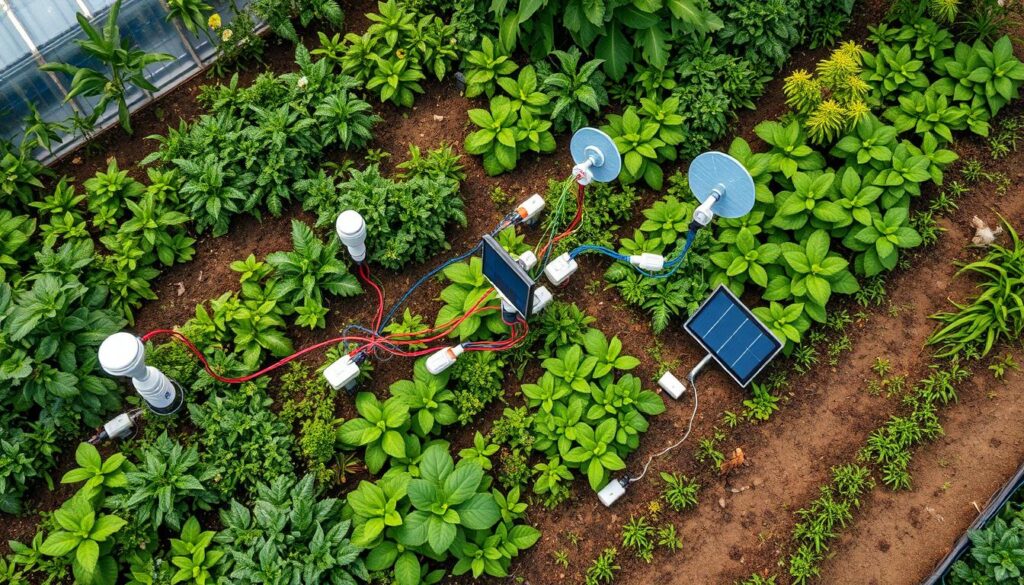
These sensors give farmers deep insights into managing crops. They make it possible to make quick decisions and use resources better.
Soil Moisture Sensors
Soil moisture sensors are key in permaculture. They track water in the soil accurately. Prices range from USD 150 to USD 5000, fitting different farm sizes.
- Measure soil water content accurately
- Enable precise irrigation scheduling
- Reduce water waste
Weather Stations
Wireless sensor networks (WSNs) use weather stations to gather detailed environmental data. They give real-time info on temperature, humidity, wind speed, and rain.
| Parameter | Monitoring Capability |
|---|---|
| Temperature | Continuous tracking |
| Humidity | Real-time measurement |
| Wind Speed | Directional analysis |
pH and Nutrient Sensors
Now, permaculture has special pH and nutrient sensors. They check soil composition with great detail. These tools help farmers choose the right fertilizers and keep soil perfect for growing.
“Sensor technologies are transforming agriculture from reactive to proactive management strategies.”
By using these sensors, farmers can get data in real-time. This helps them lower environmental harm and grow more crops. It’s all about smart monitoring and quick action.
Integration of Sensor Networks with Permaculture Designs
Permaculture design has entered a new era of technological innovation. Sensor networks are changing how farmers and gardeners work. They offer new insights into managing ecosystems.
Modern permaculture software and apps are changing traditional farming. They provide data-driven solutions for complex ecosystems. These tools help farmers monitor and intervene with precision.
Zoning Techniques Enhanced by Sensor Networks
Sensor networks help with advanced zoning strategies. They capture detailed environmental data. Farmers can now use land more accurately:
- Real-time microclimate tracking
- Precise resource allocation
- Automated zone management
Intelligent Companion Planting Strategies
AI-powered apps analyze plant interactions. They suggest the best companion planting. These smart systems predict:
- Potential nutrient interactions
- Pest resistance patterns
- Symbiotic growth opportunities
Climate Adaptation Through Advanced Technologies
Sensor networks give farmers key insights for climate-resilient farming. They analyze environmental data. Farmers can:
| Technology | Impact | Efficiency Improvement |
|---|---|---|
| IoT Sensors | Climate Monitoring | 80% Accuracy |
| AI Predictive Models | Crop Protection | 40% Efficiency Gain |
| Drone Surveillance | Pest Detection | 20 Acres per Flight |
“Technology transforms permaculture from traditional practice to a data-driven, precision ecosystem management approach.”
Case Studies: Successful Implementations
Permaculture experts are changing how we farm with new sensor technologies. These tools show how urban permaculture uses advanced tracking to improve farming.
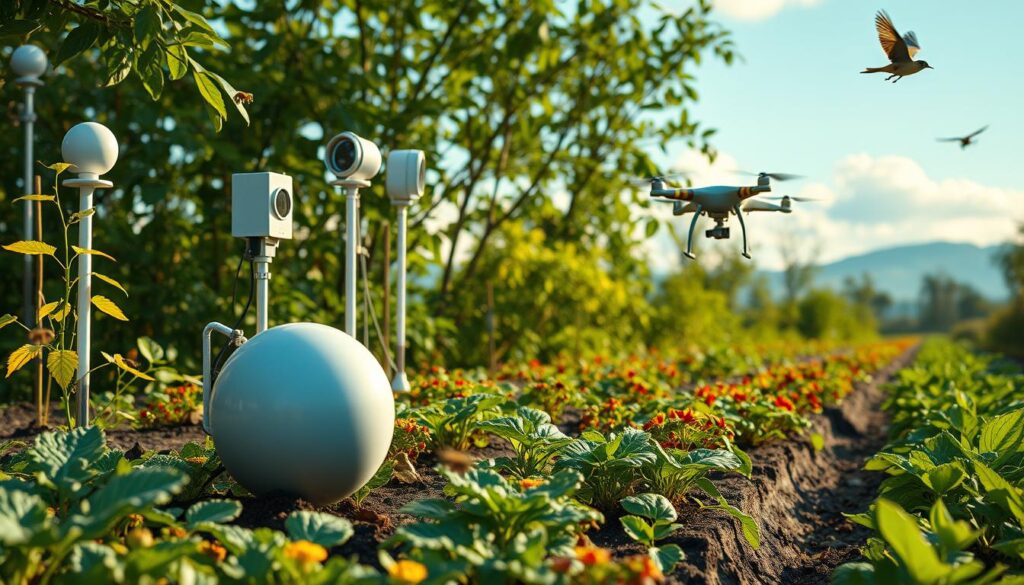
Community Garden Innovations
Urban gardens are leading the way with permaculture tools. They use sensors to track:
- Soil moisture levels
- Nutrient composition
- Microclimate variations
- Water usage efficiency
Research Farms and Sensor Technology
Research farms are using permaculture tools to make farming smarter. They use sensors to:
- Check crop health
- Improve irrigation
- See environmental risks
- Save resources
“Sensor technology transforms permaculture from reactive to predictive agricultural management.” – Environmental Research Institute
Urban Permaculture Breakthroughs
Cities are testing new ways to farm with sensors. Precision agriculture helps urban farmers understand their land better. This leads to better use of resources and more food.
Challenges in Implementing Sensor Networks
Digital permaculture resources are changing how we farm, but there are big hurdles to overcome. Integrating sensor networks into farming is complex. It needs careful thought and planning.
Setting up advanced sensor networks in permaculture comes with many challenges. Farmers must tackle these issues with care:
Initial Cost and Investment Barriers
Starting with digital permaculture resources can be very expensive. Research shows that:
- 60% of permaculture farms lack the needed infrastructure
- Setting up a sensor network costs a lot of money
- High-tech costs can scare off small farmers
Technical Knowledge Requirements
Using permaculture technology well needs special skills. Data shows that:
- 75% of farmers worry about AI making decisions
- Advanced sensor networks need technical training
- Understanding data is a big challenge
“Technology is most powerful when it empowers human understanding, not replaces it.” – Sustainable Agriculture Researcher
Maintenance and Upkeep Considerations
Keeping sensor networks running is another big challenge. Important points include:
- Keeping the system calibrated is crucial
- Updating software and hardware regularly is needed
- Finding affordable technical support can be hard
Even with these challenges, sensor networks in permaculture could bring big benefits. With the right planning and investment, they could change farming for the better.
Future of Sensor Networks in Permaculture
The world of permaculture is changing fast with new tech. These innovations are changing how we see and work with farms. They’re making sustainable farming better.
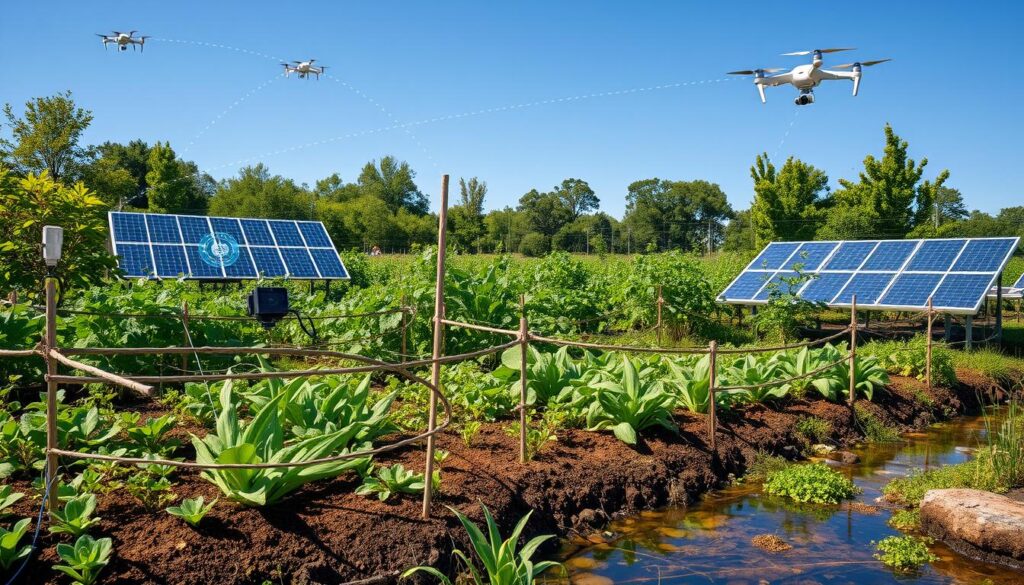
Emerging Technologies Reshaping Agriculture
Permaculture virtual reality is a new tool for designing farms. It lets farmers test out ideas before they start. They use advanced simulation tools to see how ecosystems work.
- AI-driven predictive modeling for ecosystem management
- Real-time environmental monitoring systems
- Autonomous data collection through smart drones
Potential Developments in AI and IoT
AI and IoT are changing farming with precision. Intelligent sensor networks can now analyze thousands of data points per second. This gives farmers key info on soil, crops, and the environment.
“Technology is not replacing farmers, but empowering them to make more informed ecological decisions.” – Sustainable Agriculture Research Institute
Long-Term Sustainability Goals
Permaculture virtual reality is teaching the next farmers. It creates a world where learning is fun and real. This makes farming sustainable for the young.
- Reduce environmental impact
- Optimize resource management
- Enhance ecosystem resilience
The future of permaculture is about mixing tech with human touch. It’s about creating farms that work with nature, not against it.
Training and Education in Sensor Networks
Permaculture digital tools are changing how we learn about farming. They offer new ways for farmers and experts to learn about technology. This change is making farming education more advanced and practical.
Agricultural education has changed a lot lately. Now, training programs focus on teaching farmers about technology. This is because technology is key in modern farming.
Courses and Workshops
New training options are popping up to meet the need for permaculture software skills. These include:
- Online certification programs
- Hands-on technology workshops
- Field-based sensor network training
- University-level precision agriculture courses
Resources for Farmers and Practitioners
It’s important to have good learning resources for technology. Targeted educational materials help bridge knowledge gaps in using sensor networks.
| Resource Type | Focus Area | Accessibility |
|---|---|---|
| Digital Platforms | Sensor Network Basics | Online/Free |
| Technical Manuals | Advanced Implementation | Paid/Specialized |
| Video Tutorials | Practical Applications | Mixed Access |
Community Engagement Initiatives
Community programs are key in sharing knowledge about permaculture digital tools. They help spread the word and teach people new skills.
“Technology education is the bridge between traditional farming and future sustainable practices.” – Agricultural Innovation Network
Studies show that younger, educated farmers use technology more. Teaching technology well can really help farmers use it better.
Collaborations and Partnerships
The world of permaculture is changing fast thanks to partnerships. These partnerships link technology, farming, and green living. They help create new tools and apps for sustainable farming.
Today, collaborations are building strong innovation networks. They bring together:
- NGOs working on green farming
- High-tech companies and new farming startups
- Research schools focused on solving environmental problems
NGOs in Sustainable Agriculture
Non-governmental groups are key in pushing permaculture forward. Strategic partnerships help them tackle farming issues. This is true for cities and places with limited resources.
Tech Companies and Startups
High-tech firms are making advanced apps for farming. These apps help farmers manage resources better. They offer insights on crop health and soil conditions.
| Collaboration Type | Key Benefits | Innovation Potential |
|---|---|---|
| NGO-Tech Partnerships | Knowledge Transfer | High |
| Academic-Industry Collaboration | Research Development | Medium-High |
| Startup Ecosystem | Rapid Prototyping | Very High |
Academic Institutions
Universities are key for permaculture research. They add science and new ideas. This turns ideas into real farming solutions.
“Collaboration is the cornerstone of sustainable technological advancement in agriculture.” – Global Agriculture Innovation Network
These partnerships are building a strong network. They share knowledge, innovate, and promote green farming.
Policy and Regulation Considerations
The mix of tech and green farming needs smart rules. It’s important to find new ways to help new farming tech grow.
Government Support for Innovative Farming
More governments see how digital tools can change farming. They’re starting to help by backing new permaculture tools for better farming.
- Develop targeted grant programs for agricultural innovation
- Create tax incentives for sustainable technology implementation
- Support research and development in precision agriculture
Environmental Regulations
Good rules are key for green farming tech. They help keep farming safe for the planet.
| Regulation Category | Key Focus Areas |
|---|---|
| Data Privacy | Protecting farmer information and agricultural data rights |
| Technology Standards | Establishing guidelines for sensor network deployment |
| Environmental Impact | Monitoring sustainable technology implementation |
Proposed Policies for Sustainable Tech
New rules are needed for farming tech. Working together can make better rules for everyone.
“The future of agriculture lies in intelligent, adaptive policy-making that supports technological innovation while protecting ecological systems.” – Agricultural Policy Expert
Digital tools are changing farming. They bring new chances and challenges for rules makers across the country.
Measuring Impact: Metrics for Success
Measuring the success of permaculture technology is key. New tools have changed how we check if farming works well. They help farmers and researchers see how good their systems are.
Key Performance Indicators (KPIs)
Good permaculture needs important metrics to show its impact. The top KPIs are:
- Resource efficiency
- Crop yield optimization
- Water conservation rates
- Ecosystem biodiversity improvements
- Input cost reductions
User Feedback and Case Study Evaluation
Listening to those who use permaculture is vital. Real-world experiences offer key insights into how well systems work and how they can get better.
Data-driven approaches transform agricultural practices from guesswork to precision management.
Long-Term Sustainability Metrics
Looking at long-term results is also important. Key metrics for the long haul are:
- Soil health improvement
- Carbon sequestration rates
- Biodiversity enhancement
- Economic viability
USDA data shows U.S. farm output tripled from 1948 to 2017. This happened with almost no increase in inputs. It shows the power of advanced permaculture tools.
Adding precision agriculture tech is speeding up. It promises even better ways to track and boost farm performance.
Conclusion: The Future of Permaculture with Sensor Networks
The world of sustainable farming is changing fast with new tech. Sensor networks and AI are key in making permaculture better. They give farmers new ways to manage their land and crops.
These tools help farmers work smarter, not harder. They can now use data to grow more food while protecting the environment. This is a big win for both farmers and the planet.
Virtual reality and simulation tools are also changing farming. They help farmers design and plan better. AI is making these tools even more powerful, helping farmers manage their land better.
These tools are not just improving farming. They are also helping farmers keep their land healthy. By using AI, farmers can spot problems early and fix them fast.
Summary of Key Takeaways
Technology is making farming better in many ways. AI and sensors are cutting down on harmful chemicals and improving data accuracy. This leads to farming that is both productive and kind to the environment.
Simulation tools are a big step forward. They help farmers understand how different parts of their farm work together. This lets farmers plan and predict with more accuracy.
Call to Action for Farmers and Stakeholders
We are at a turning point in farming. It’s time for farmers, researchers, and tech experts to work together. By using new tech, we can make farming better for everyone.
Let’s use virtual reality and advanced sensors to make farming more sustainable. This way, we can grow food while taking care of our planet.
Vision for the Next Decade
The future of farming is bright. We will see farms that are smart and work with nature. With more tech, we will grow more food and protect our land better.
The next ten years will be full of new ideas and changes. We will learn more about how to farm in a way that’s good for everyone.

